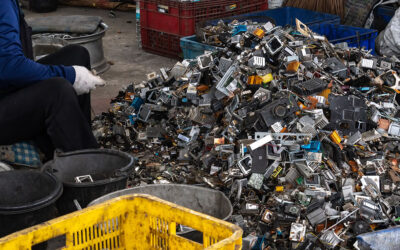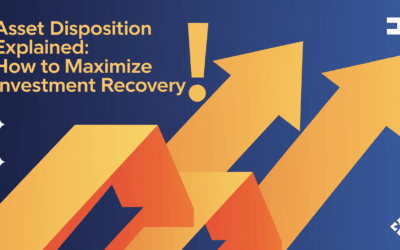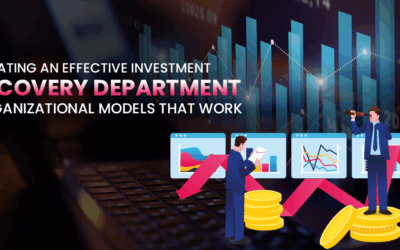Investment Recovery Strategies for End-of-Life Assets: Balancing Economics and Ethics
When companies address the disposal of end-of-life assets, they must navigate the fine balance of achieving financial value while complying with ethical standards. Here, having effective investment recovery strategies can help turn potential losses into revenue, reduce storage costs, and also support environmental sustainability goals. With increasing competition and brand image at stake, companies can no longer ignore determining and implementing these strategies.
So, let’s get started.
Defining Asset and Asset Life Cycle Management
An asset can be defined as a material or resource that is useful and valuable to an organization. It may include real estate, machinery, equipment, facilities, tools, vehicles, warehouses, chemicals, furniture, electronics, and others depending on the type of industry.
Asset lifecycle is the process of acquiring, utilizing, monitoring, maintaining, and disposing of an asset, and asset lifecycle management, on the other hand, refers to the process or system of optimizing the lifecycle of these assets through planning and maintenance to increase their lifespan and functionality.
What Are End-of-Life Assets?
End-of-life assets are defined as assets that have reached the end of their productive lifecycle and are no longer operationally effective and economically viable for the business. These assets are usually decommissioned and retired from their service and are disposed of by recycling, reusing, refurbishing, or reselling them.
How to Identify End-of-Life Assets for Your Investment Recovery Strategies
Assets may reach the end of their life cycle due to various reasons including their age, wear and tear, being technologically obsolete, change in business priorities, economic considerations, and environmental and safety concerns.
Here are a few questions to determine end-of-life assets.
- Is the product still bringing in sufficient revenue to support the maintenance cost?
- Has the product completed its age and whether maintaining its wear and tear is financially and economically viable?
- Is the product compatible with the latest technology or has it become obsolete?
- Is the product complying with the latest safety standards, regulatory requirements, and environmental regulations?
- Is the asset still in alignment with the current business needs, strategies, and objectives?
Investment Recovery Methods for End-of-Life Assets: Balancing Ethics and Economics
Organizations must act responsibly and ethically while focusing on their bottom line, and this is where choosing the effective investment recovery method can make a difference.
Refurbishment and Redeployment
This approach involves refurbishing and repairing the product for it to be used for similar or different purposes.
Benefits:
- More cost-effective and environmentally sustainable
- Familiarity with the equipment ensures ease of use
Drawbacks:
- Higher chances of equipment breakdown
- Difficulty in integrating with the new tools and technology
Resale
Assets can be resold through various means such as auctioning, private sale, third-party sale, and others. An asset that is considered worthless for one organization might prove beneficial for another.
Benefits:
- Helps in recouping the value of the assets
- Boosts cash flow that can be used in necessary business tasks
Drawbacks:
- Quite complex and time-consuming
- Needs a dedicated person or team to design and strategize the complete process
Donation
These assets can be donated to charitable trusts, smaller organizations, or community groups that might benefit from its use.
Benefits:
- Supports the community and industry at large
- Might offer some tax benefits
- Helps build a better brand reputation
Drawbacks:
- Some assets might not be in a condition to be beneficial for other prospects
Disposal
For the assets that cannot be reused, refurbished, or resold for any value, scrapping and disposing of them properly as per environmental and safety regulations can be a better alternative. Additionally, for assets that are hazardous or need special handling, the process should be commissioned to certified vendors who can do it responsibly and ethically.
Benefits:
- Safe, responsible, and ethical process
- Hazardous material does not end up in the landfill
- Helps reclaim the scrap value of metal and other important elements
Drawbacks:
- No guarantee of the financial benefits
Environmental and Ethical Benefits of Investment Recovery Strategies
Here’s a quick look at the ethical and environmental benefits of effective investment recovery strategies.
- Cash flow: The investment recovery of end-of-life assets helps recoup the value of the assets and generate the necessary cash flow for businesses.
- Resource conservation and optimization: Refurbishing, redeploying, reusing, and recycling of end-of-life assets reduces the demand for new resources and minimizes the environmental impact associated with manufacturing, packaging, and resource extraction.
- Reduced environmental waste: Investment recovery of assets reduces the amount of waste sent to the landfill, thus, alleviating pressure on landfill capacity and mitigating environmental pollution and greenhouse gas emissions.
- Freeing up space: Phasing out end-of-life assets has a direct implication on freeing up occupied space that can be used for other business purposes.
- Cost savings: By refurbishing and redeploying the assets, organizations can save on the cost of buying new assets and avoid any associated disposal fees.
- Regulatory compliance: By adhering to regulatory compliances and regulations, organizations can avoid potential fines, penalties, and reputation damage while ensuring corporate social responsibility.
Investment Recovery Strategies: Best Practices Businesses Should Consider
There is a growing emphasis on corporate responsibility and sustainability, driven by consumer expectations and regulatory requirements. This has led businesses to consider and adopt the following best practices.
Lifecycle Assessment
Implement comprehensive lifecycle assessments for all assets to understand their environmental impact from production to disposal. This can help businesses in making informed decisions about asset management and recovery.
Transparent Reporting
Maintain transparency in your sustainability efforts, including the reporting of methods and results in asset recovery. This helps build trust and credibility with stakeholders such as consumers, investors, and regulatory bodies.
Stakeholder Engagement
Regularly engage with stakeholders to gather insights and feedback on environmental practices and expectations. This can guide your strategic decisions and help your business align its practices with stakeholder values.
Training and Education
Invest in training and education of your employees on sustainability practices, especially focusing on the end-of-life handling of assets. Educated employees are better equipped to implement and innovate on best practices.
Final Words
In the continuously evolving technological landscape where assets are fast-moving and become obsolete sooner than later, businesses need to plan for an end-of-life asset disposition strategy. Companies need to be proactive in adopting comprehensive investment recovery strategies, which not only enhance operational efficiency and financial value but also uphold environmental and ethical standards. By embracing these practices, you can ensure compliance, boost sustainability, and position your business as a responsible leader in the industry, maintaining its competitiveness and reputation.



